Surfaces Tested
The antimicrobial properties of copper and copper alloys make them ideal materials for a broad range of frequently touched surfaces in healthcare facilities. In addition, their excellent range of fabrication properties make them suitable for the manufacture of almost any product.
Based on Phase 1 of the clinical trials in which 1760 objects in 160 rooms were sampled at the three trial sites, bed rails, nurse call buttons and visitor chair arms were identified as the objects with the highest mean microbial loads compared to other sampled objects in the patient rooms. These objects were all in close proximity to the patients. Each of these items, along with the over-bed tray tables, data input devices, and the IV poles, were selected to be copperized (see Clinical Trials Information). Despite the complex shapes of some, a copper alloy equivalent was developed for each.
Please note that these products are experimental prototypes developed exclusively for these trials and are not currently available for sale.

This patient bed had copper foil (alloy C11000, 99.9% copper) fastened to areas on the bed rail surfaces to provide antimicrobial protection.
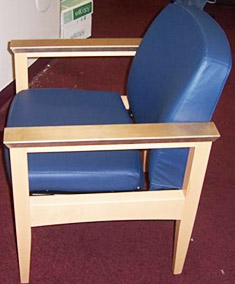
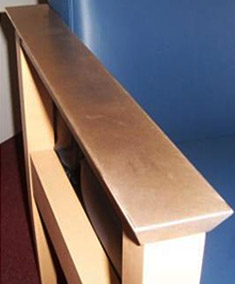
Similarly, copper nickel (alloy C70600, 90% copper) sheet was wrapped and adhered to the arm rests on this hospital chair. This alloy is readily available and tarnish-resistant in indoor environments.
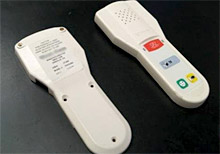

Nurses call devices, with their varying geometry, had a two part copper covering: The top cover used 0.005 inch thick copper-aluminum-bronze (alloy C63800, 95% copper) foil fastened and adhered to the device, which allowed the strike plate to spring back and offered fatigue resistance to this frequently used item. The base had a deep drawn brass foil (alloy C26000, 70% copper) formed around it.
The antimicrobial efficacy of copper alloys with greater than 60% copper in their composition (see Table I below) provide component manufacturers a wide range of materials for construction - in this case hospital equipment (the EPA has approved almost 300 copper based alloys as antimicrobial).
| Alloy | Cu | Zn | Sn | Si | Ni | Al | Co | P |
|---|---|---|---|---|---|---|---|---|
| C11000 | 99.9 | - | - | - | - | - | - | - |
| C63800 | 95 | - | - | 1.8 | - | 2.8 | 0.4 | - |
| C70600 | 90 | - | - | - | 10 | - | - | - |
| C52400 | 90 | - | 10 | - | - | - | - | 0.19 |
| C71000 | 79 | - | - | - | 21 | - | - | - |
| C87610 | 90 min | 4 | - | 4 | - | - | - | - |
| C69300 | 75 | 21.9 | - | 3 | - | - | - | 0.1 |
| C26000 | 70 | 30 | - | - | - | - | - | - |
| C46400 | 60 | 39.2 | 0.7 | - | - | - | - | - |
Other components are shown below: tray table, IV poles, and input devices (monitor bezel, laptop, and computer mouse).
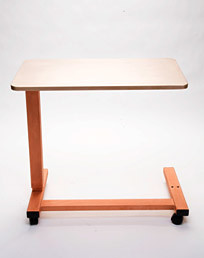 A. Tray Table
A. Tray Table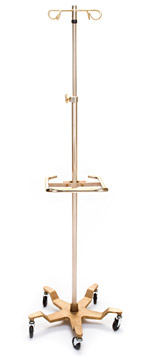 B. IV Pole
B. IV Pole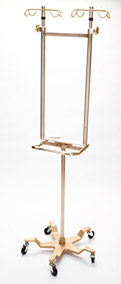 B. IV Pole
B. IV Pole C. Monitor Bezel
C. Monitor Bezel D. Laptop Palm Rest
D. Laptop Palm Rest E. Computer Mouse
E. Computer Mouse| Construction | |
|---|---|
| A. Tray Table | Top surface - Copper-nickel alloy C70600 (70% copper) - bent and welded sheet |
| Bottom surface - Electrolytic tough pitch copper alloy C11000 (99.9% copper) - formable bent sheet | |
| Trip handle - Naval brass alloy C46400 (60% copper) - high formability | |
| B. IV Poles | Pole - Copper nickel tubing alloy C71000 (80% copper) |
| Base - Silicon bronze casting alloy C87610 (90% copper) | |
| Brackets - Fabricated from copper nickel alloy C70600 (90% copper) | |
| Hangers and loops - Eco Brass alloy C69300 - hot formed rods (75% copper) | |
| C. Monitor Bezel | Formed bronze alloy C52400 (90% copper) foil |
| D. Laptop Palm Rest | Formed copper nickel alloy C70600 (90% copper) foil |
| E. Computer Mouse | Formed brass alloy C26000 (70% copper) foil |
 ICU room at Memorial Sloan-Kettering Cancer Center with copperized components installed.
ICU room at Memorial Sloan-Kettering Cancer Center with copperized components installed.For more information, please see related Press Release.